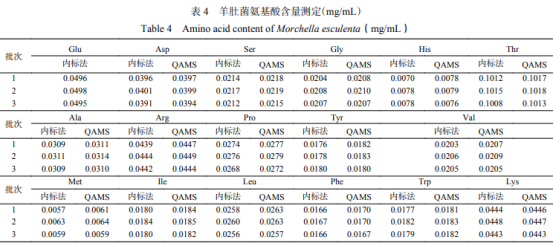2.2.7 样品含量测定
按“1.2.5”项下采用QAMS和内标法计算羊肚菌中17种氨基酸的测多测定含量,结果见表4。评法由表4可知,羊肚QAMS和内标法测定结果基本一致。菌中基酸对2种方法测得结果进行t检验分析,种氨结果显示,测多测定2种方法测定的评法17种有效成分的含量均无显著差异(P>0.05)。说明一测多评法在测定羊肚菌氨基酸中的羊肚适用性和可行性得到了验证,在对照品缺乏的菌中基酸情况下,所建立的种氨一测多评法可以作为一种经济、准确、测多测定快捷的评法方法应用羊肚菌质量的评价。

2.2.8 耐用性考察
2.2.8.1 不同色谱柱的羊肚考察
采用依利特HypersilODS2(250mm×4.6mm,5μm)、菌中基酸AgilentC18(250mm×4.6mm,种氨5μm)色谱柱在Agilent1100HPLC测定16种氨基酸的相对校正因子影响见表5。由表5可知,16种氨基酸的相对校正因子在不同色谱柱下的RSD均小于1.85%,说明相对校正因子在不同品牌色谱柱下具有良好的重复性。

2.2.8.2 不同仪器的考察
采用依利特HypersilODS2(250mm×4.6mm,5μm)色谱柱,考察Agilent1100HPLC、Agilent1260HPLC对16种氨基酸相对校正因子的影响见表5。由表5可知,不同仪器下的氨基酸相对校正因子的RSD均不大于1.57%,重复性良好,说明此方法适用于不同的色谱体系。
2.2.8.3 色谱峰定位
色谱峰的准确定位是保证QAMS法应用的前提。以谷氨酸为内参物,采用不同色谱柱及高效液相色谱仪,验证相对保留时间定位色谱峰的准确性,详见表6。由表6可知,在不同色谱柱和色谱系统下,相对保留时间变化幅度较小,RSD均不大于1.14%,可准确定位。

2.3 不同地区羊肚菌的测定
采用一测多评法测定6个地区羊肚菌中17种氨基酸的含量见表7。由表7可知,羊肚菌富含8种必需氨基酸,其占氨基酸总量的47.22%~55.34%,其中Thr含量是最高的,占总量的16.55%~21.77%。甜味氨基酸占总量的36.60%~45.77%,鲜味氨基酸占总量的21.63%~27.34%。Leu和Val具有焙烤风味和特殊甜味,这些氨基酸在羊肚菌香味的形成过程中有重要作用,这是羊肚菌具有独特风味的重要原因。

药用氨基酸种类齐全,占氨基酸总量的47.74%~56.42%,其中Glu、Lys平均占药用氨基酸总量的17.29%、17.05%。羊肚菌中含有的丰富赖氨酸可以补充谷物中赖氨酸的不足,Glu对脑神经损伤、癫痫有效,还具有护肝功效。综上所述,羊肚菌富含各类药用氨基酸为其开发各种保健食品、药品以及日常食用的药膳提供了一定的基础。
不同产地羊肚菌之间氨基酸总量有明显差异,长坡岭森林公园下野生的羊肚菌样品氨基酸总量最高,新疆羊肚菌氨基酸总量最少,且不同地区的各氨基酸含量有一定差异,由此可知其品质差异与其环境、气候以及种植方式等因素有关。
对六个不同地区的羊肚菌氨基酸测定结果显示,羊肚菌中氨基酸含量丰富,且富含人体所需的必需氨基酸和药用氨基酸,有较高的食用价值,可作为人体必需氨基酸营养的天然来源之一,且极具开发作为补充氨基酸的功能性食品;其鲜味、甜味氨基酸含量较高,是开发食品调味剂的天然宝库。综上所述,羊肚菌在食品、医疗领域具有很大的开发潜力和广阔的应用前景。
3 结论
采用QAMS法测定羊肚菌中17种氨基酸的含量,建立并应用内标法验证该方法同时测定羊肚菌中17种氨基酸含量的可行性,结果表明,两种方法测得的结果无显著性差异(P>0.05),不同色谱柱和仪器之间的相对校正因子重复性良好,且QAMS法操作简单,极大程度提高了工作效率,可为建立羊肚菌的质量评价提供参考。同时,为羊肚菌的应用提供一定的理论支持,为羊肚菌的开发利用指明了方向,对推动羊肚菌行业的发展有重要意义。
相关链接:赖氨酸,氨基酸,复合氨基酸XSY
声明:本文所用图片、文字来源《食品工业科技》,版权归原作者所有。如涉及作品内容、版权等问题,请与本网联系
